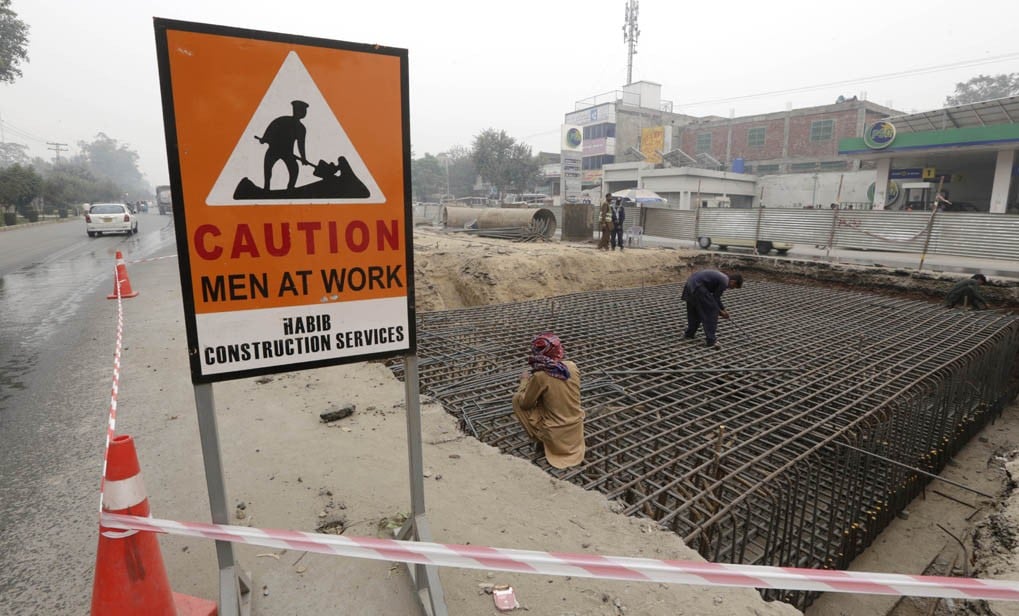
The citizens of Lahore are opposed to political projects that may change the character of a living ancient city in the name of development

The story of the Lahore Mass Transit System (LMTS) goes back to the early 1990s when a priority corridor was identified. However, no further action was taken then. But with the rising population of the metropolis and its commuter needs estimated at 13.5 million passenger trips by 2006, the Pervez Elahi government commissioned MVA Asia to conduct a feasibility study of the mass transit system in 2005.
The study identified four corridors (Green, Orange, Blue, Purple Lines) integrated through multi-nodal terminals termed the Lahore Rapid Mass Transit System (LRMTS). It further identified the Green Line on Ferozpur Road as the highest priority with an estimated cost of $2.4 billion followed by the Orange Line with an estimated cost of about $2 billion. The project moved ahead as a $6million loan was sanctioned by the Asian Development Bank for a detailed implementation plan, but with the change in government, the project was cancelled and the stated loan lapsed in 2009.
The same project was restarted under a new name and changed design with the Turkish assistance in 2011. The new Rapid Bus Transit System (RBTS) called the Lahore Metro Bus was termed more cost effective as it converted the whole 27km Green Line to elevated (over ground) platform, rather than a mixed 10.5km elevated -- 11.5km underground and 5km elevated rail design with 10 elevated and 12 underground stations. In comparison with Bus, the Rail system was faster and more suited to long term needs of Lahori Green Line commuters because it could carry 60,000 passengers/hour (total both ways) as opposed to 24,000 maximum for the Bus system. This combined with underground stations in the older section of the city made technical, economic, and environmental sense in addition to preservation of cultural heritage.
Barring all above objections to the Rapid Bus Transit System, the Green Line Metro Bus was a huge political success completed in a short period of two years in 2013 just in time for elections, rather than expected time of completion in 2015. Further, the Punjab government stated that it had spent only Rs30 billion on the project as opposed to the $2.4 (Rs. 180) billion estimated in the original design, but the cost was questioned repeatedly.
Another twist came when news reports indicated that the May 9, 2013 fire of the LDA Plaza, which led to the death of 25 people, also destroyed the files of Lahore Metro Bus project subpoenaed by the NAB. But this was denied by the Director General LDA and the story soon faded away as is the case in our investigative-less reporting media. For the general public (in Lahore and Punjab) though, seeing and experiencing Metro Bus was enough to propel the PML-N into power in the Centre with strong backing in Punjab. Since then, the Metro Bus has been projected as the element of development and enlightened leadership with similar projects in Rawalpindi-Islamabad and Multan.
After two year in government, it is Metro Bus time again in the city of Lahore with the Orange Line now doing the rounds. As has been the practice of the Shahbaz Sharif government, the people of Chauburji (17th century Mughal building), the General Post Office (the 19th century British building), and Shalamar Gardens (a world heritage site) recently found out that the Orange Line will hinder the view of these buildings, thus forever destroying the status and financial income Lahore could achieve as a major tourist city like Delhi (with an underground metro), Istanbul (a metro designed with archeology and heritage in mind taking longer than an election term) and others. Further, and more importantly, the destruction of businesses, shops and city life makes the social costs unbearable.
This has propelled the citizens of Lahore into action. Multiple meetings have been held as well as street protests at Chauburji and GPO under the banner of Lahore Bachao Tehreek with the slogan of Rasta Badlo (Change the Route). However, an expert who had led the original planning of LRMTS states that the only difference is that the current plan has a 1.72 km underground as opposed to the 7 km underground route on which feasibility study had originally been done, public meetings held, and citizens taken into confidence. It is actually because of this shortened underground section that he feels that we are again building an un-sustainable mass transit system because an elevated design would lead to destruction of built infrastructure, increased cost to acquire costly land and increased sound pollution destroying the character of the city forever.
The expert further adds that the new elevated design will also be ineffective because it does not include a direct underground link with the Railway Station. The original plan of the Orange Line was a 12 km elevated section on viaduct from Ali Town, followed by 7 km underground middle section from Chauburji to Sultanpura and then the 8 km north-east section from Sultanpura to Dera Gujran again on elevated viaduct. The citizens of Lahore would welcome this original plan as it also preserves the city’s cultural heritage while providing the needed commuter service.
But this design cannot be finished before the next elections. Thus it does not fulfil the real purpose of the project -- the short term political incentive of 2018 elections. Additionally, if the current design and financial cost are made transparent through public disclosure and discussion (a good governance and democratic requirement of all public projects of this magnitude), it could open up the project to public scrutiny and raise all kinds of sustainability, technical, environmental, heritage and other issues of illegal budgetary provision from other heads leading to charges of Takht Lahore and Thekedari Raj.